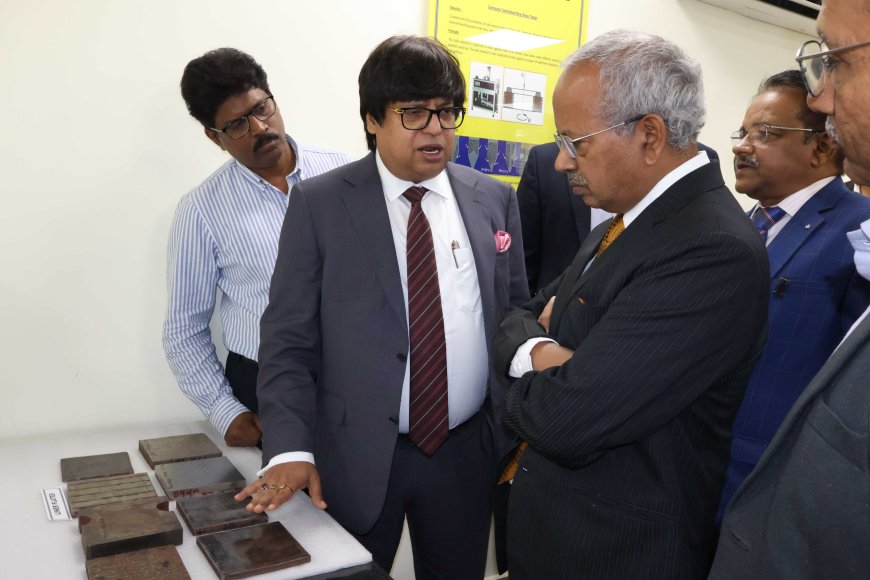NMDC’s R&D facility is making giant strides, silently

Since its establishment in 1958, NMDC has consistently pushed boundaries to emerge as the country’s single-largest iron ore producer and the world’s eighth-largest. This remarkable journey of over 66 years has not only
seen the Navaratna company making giant strides within and outside the country, including acquiring a mine in Australia and operationalising a three million tonnes per annum (MTPA) steel-producing unit in Chhattisgarh, but also significantly impacting the global mining and steel sector.
However, what often goes unnoticed is the versatility of its well-equipped R&D centre. Beyond the media spotlight, this unit serves in-house projects and regularly takes up sponsored work for external clients, including SAIL and AM/NS India. This underlines the centre's significant impact and its proven ability to cater to diverse needs, providing reassurance of its capabilities.
Established in 1975 in Faridabad, the R&D unit was initially set up to support in-house projects and domestic organisations in various fields, including mineral processing, bulk solids handling, agglomeration, hydrometallurgy, etc. UNIDO and DSIR recognise it as a Centre of Excellence, a testament to its knowledge and technology transfer to the domestic and global industry.
The early eighties saw various organisational changes in the company. NMDC's headquarters was moved to Hyderabad, and the R&D centre to Uppal, a few kilometres from the new head office.
Always keen on fostering innovation and pursuing excellence, NMDC has taken one step forward, operationalising a new state-of-the-art R&D centre at Patencheru in Hyderabad. The significant investment of Rs 200 crore in the past five years is a clear indication of NMDC's unwavering commitment to advancing innovation in mineral processing and sustainable steel technology, paving the way for a promising and confident future.
The newly inaugurated NMDC R&D Centre boasts an array of sophisticated instruments, including an automated mineral analyser and an automated fusion bead-based X-ray fluorescence (XRF) analyser, ensuring precise and efficient characterisation of various minerals. The Centre features a dedicated facility for pelletisation studies, which generates crucial data for the installation of commercial pellet plants.
The NMDC R&D Centre is home to various specialised laboratories, each contributing to the company's inhouse requirements and capabilities. These include a mineralogy laboratory, a mineral processing centre, an iron and steel research lab, a hydro metallurgy laboratory, a bulk solids flow laboratory, and a chemical laboratory. Each lab has its specific task, and together, these facilities provide valuable insights into mineral processing and pellet production, benefiting not only NMDC but also the wider sector.

Amitava Mukherjee, CMD, NMDC, said, “Embracing our responsibility to innovate and lead the Indian mining industry towards a sustainable future through research and development, we open the doors to NMDC's new
state-of-the-art R&D center. As we strive to innovate and inspire, we have not just invested in research here; we have invested in India's Future.”
“This facility is a decisive step towards driving the digital transformation of India's largest iron ore producer and will further reinforce its commitment to Responsible Mining by building a sustainable ecosystem at its core,” he added.
NMDC's R&D facility is now engaged in various development projects. Aimed at mineral conservation, the Centre is exploring multiple beneficiation process flows – wet and dry – for different combinations of products of lumps, sinter fines and pellet fines for low-grade lateritic or limonitic ore from the Bailadila sector. The project is likely to be completed in a year. It has also taken up a project to optimise the pelletisation process parameters for iron ore containing a high amount of goethite. Another ongoing exploratory project using nontraditional binders in pelletisation aimed to reduce environmental impact and improve pellet quality is ongoing.
Also, some collaborative research projects involving CSIR-IIMT Bhubaneswar to study the feasibility of preparing fused magnesia from kimberlite trailings and a study on conveying the characteristics and behaviour of iron ore in pneumatic conveying systems are in progress.
The Centre has set up a fully automated pilot-scale iron ore beneficiation facility to treat low-grade iron and an automatic sample collection and robotic lab for elemental analysis of iron ore at all three NMDC projects: Bacheli, Kirandul, and Donimalai.







